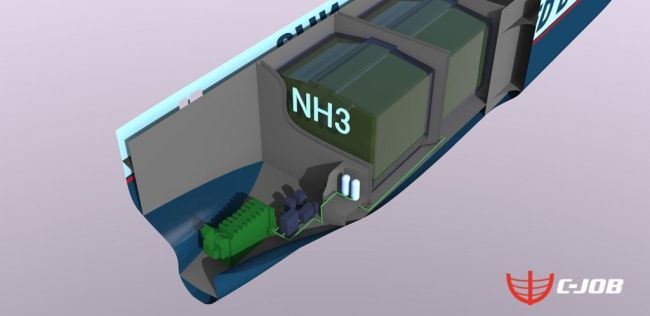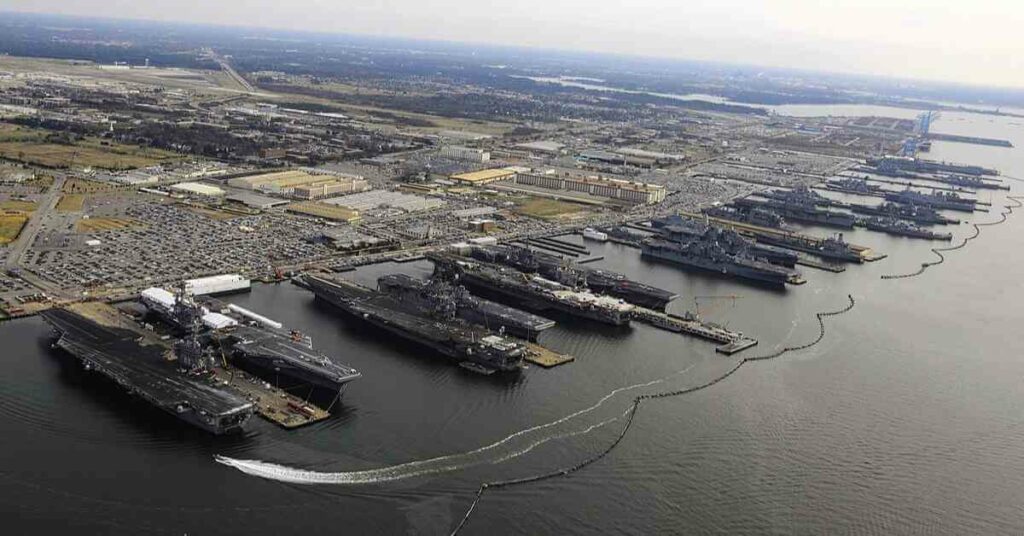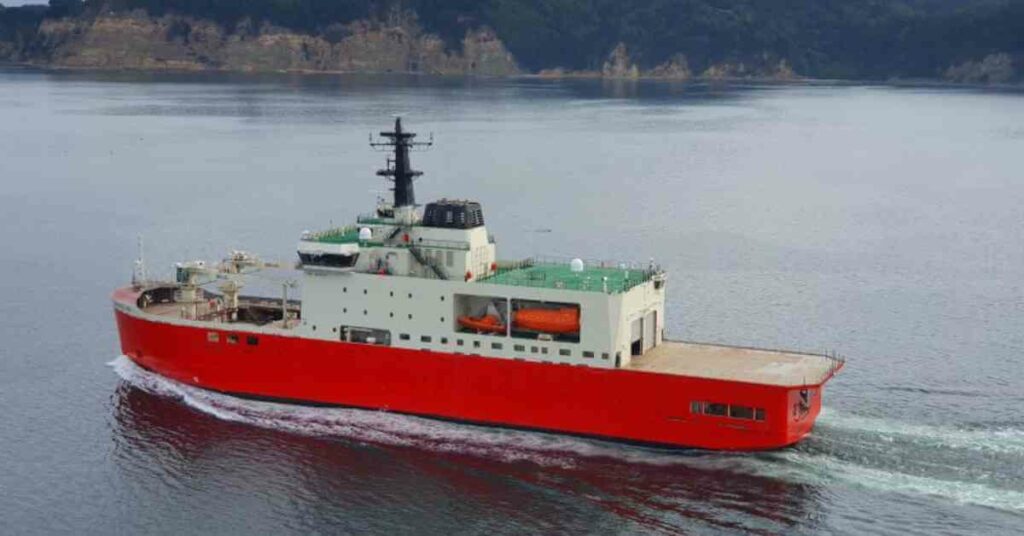Ammonia As Ship’s Fuel: C-Job Plans Future-Proof Way Of Thinking
In terms of fuel, the shipping industry is becoming more and more aware of its impact on the environment. Considering the long-term, what sustainable fuels present viable and realistic possibilities for the maritime sector? One option that is just too promising to be overlooked is ammonia, says C-Job Naval Architect Niels de Vries. “Ammonia is easily sourced and has carbon-free emissions. Furthermore, thanks to the long-standing fertilizer industry, safe working practices are well established.”

Ammonia as energy storage
The main inspiration to use ammonia as a fuel came from Professor Dr. F. M. Mulder while Niels was following a course at Delft University of Technology. “Renewable energy sources like wind and solar power often provide more energy than the market needs. Professor Mulder put forward the idea that this energy surplus can be utilized to produce – and therefore be stored in – a renewable fuel.”
Niels took this initial concept and developed it into a more tangible strategy. “Using this periodic overcapacity of renewable energy, we can produce ammonia, also known as NH3, by binding nitrogen with hydrogen.” The nitrogen is sourced from existing air separation methods; after all, air is made up of 78% of nitrogen. The hydrogen is produced through the electrolysis of water. “Water and nitrogen are both abundant substances, which makes ammonia a future-proof fuel.”
Potential for propulsion
Regarding propulsion technology, using ammonia as a fuel doesn’t take a major leap of the imagination. “An internal combustion engine can be used to burn the ammonia. This requires a catalyst to crack a small portion of ammonia into nitrogen and hydrogen. The pure hydrogen ignites and burns with the ammonia,” Niels continues. “This technology exists – in fact, the first ammonia-powered car dates back to 1935 – it just needs to be applied in much larger engines with modern techniques.”
Other alternatives involve using fuel cells. “Proton Exchange Membrane Fuel Cells are commercially available and are used, for example, in submarines in a number of navies around the world. Here, the ammonia is fully separated, and the hydrogen is then used to generate electric power.” Using Solid Oxygen Fuel Cells is also an option where ammonia can be used directly, but requires further research to determine its viability.
Working temperatures
On the crucial subject of safety, Niels goes on to say that the fertilizer industry has more than 100 years of experience working with ammonia. “There are well established regulations in the industry that have been set up over the years. Using the knowledge and experience of the people working in this sector one could develop maritime safety standards using ammonia as a fuel. In the terms of storage, this industry already uses large tanks capable of holding 60,000 tonnes of ammonia. Furthermore, large tankers have been used for decades to transport up to 80,000 tonnes of ammonia across the oceans.” Another noteworthy point is that ammonia can be stored in its liquid state at the relatively workable temperature of -33.4°C (at 1 bar pressure).
To give a balanced impression of the pros and cons of ammonia as a ship’s fuel, it must be noted that, compared to Heavy Fuel Oil, ammonia weighs twice as much and requires three time more space to contain the same amount of energy. Such issues will have to be taken into account for ammonia-powered ships. Furthermore, ammonia is known to be a toxic substance; a fact that will need to be addressed when developing a safe and class-compliant ship design.

The role of C-Job
“The most challenging aspect, however, is the business case concerning ammonia. At the moment, the maritime industry relies on HFO and MDO, which are the cheapest, but also the most polluting options. The business case for ammonia as a ship’s fuel will have to be supported by regulatory and economic factors in order to progress further.”
And how does C-Job see itself in this long-term picture of ammonia as a fuel? “We think that ammonia could be a viable and promising option for a clean and sustainable fuel,” says Niels. “And our role is clear. Designing sustainable and future-proof vessels – an ammonia-powered ammonia carrier, for example.”
Reference: c-job.com
Disclaimer :
The information contained in this website is for general information purposes only. While we endeavour to keep the information up to date and correct, we make no representations or warranties of any kind, express or implied, about the completeness, accuracy, reliability, suitability or availability with respect to the website or the information, products, services, or related graphics contained on the website for any purpose. Any reliance you place on such information is therefore strictly at your own risk.
In no event will we be liable for any loss or damage including without limitation, indirect or consequential loss or damage, or any loss or damage whatsoever arising from loss of data or profits arising out of, or in connection with, the use of this website.
Disclaimer :
The information contained in this website is for general information purposes only. While we endeavour to keep the information up to date and correct, we make no representations or warranties of any kind, express or implied, about the completeness, accuracy, reliability, suitability or availability with respect to the website or the information, products, services, or related graphics contained on the website for any purpose. Any reliance you place on such information is therefore strictly at your own risk.
In no event will we be liable for any loss or damage including without limitation, indirect or consequential loss or damage, or any loss or damage whatsoever arising from loss of data or profits arising out of, or in connection with, the use of this website.
Do you have info to share with us ? Suggest a correction
About Author
Marine Insight News Network is a premier source for up-to-date, comprehensive, and insightful coverage of the maritime industry. Dedicated to offering the latest news, trends, and analyses in shipping, marine technology, regulations, and global maritime affairs, Marine Insight News Network prides itself on delivering accurate, engaging, and relevant information.

About Author
Marine Insight News Network is a premier source for up-to-date, comprehensive, and insightful coverage of the maritime industry. Dedicated to offering the latest news, trends, and analyses in shipping, marine technology, regulations, and global maritime affairs, Marine Insight News Network prides itself on delivering accurate, engaging, and relevant information.
Latest Shipping News Articles You Would Like:
Subscribe To Our Newsletters
By subscribing, you agree to our Privacy Policy and may receive occasional deal communications; you can unsubscribe anytime.









